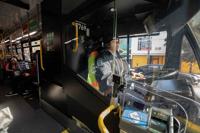
View of how the expanded barriers look on Metro buses. (Photo by Aurelia Ventura)
Metro has installed new barriers to protect bus operators on more than 2,000 buses.
According to Metro's blog post, the new barriers fully enclose and protect bus operators. It makes Metro the first transit agency in the U.S. to equip its entire bus fleet with these type of barriers.
“Since the bus barrier was installed on my bus, I feel protected and safe,” Rosaelba Ramírez-Gonzales said.
The mother of a seven-year-old boy admits that when she started at Metro a year ago, she felt uneasy after hearing about assaults on bus operators. That worry has since faded.
The initiative was launched earlier this year in response to an increase in attacks on bus operators.

Metro bus operator Rosaelba Ramírez-Gonzales. (Photo by Aurelia Ventura)
The number of major assaults on transit workers tripled between 2008 and 2021, according to the Federal Transit Administration.
Los Angeles County Supervisor Janice Hahn said last year, after a man was killed in a Metro bus, that she wants to see an expansion of weapon-detecting systems -- which are being tested at Union Station -- across the Metro system to prevent people from carrying guns or other deadly items on buses and trains.
In April, the Metro Board of Directors approved an emergency procurement action to install full bus barriers on all service buses reducing the project’s time to completion from possibly three years to a few months.
“Personally, I’ve never been attacked, but months ago my family were hearing stories on the news and started asking about my safety,” said Tracey Davis, a Metro bus operator for three years. “So, when Metro announced the bus barriers, I was excited… It felt like better protection for us.”
Metro leadership worked in collaboration with bus drivers so employees could see prototypes of the barriers and learn about the project timeline.
“I saw how the barrier would look on the bus and provided feedback in an online survey,” Davis said.
This photo illustration shows the difference between the old barriers and new barriers. At left the area outlined in yellow are the older barriers — leave the area in red open. At right, the new barriers block the entire area in yellow.

(Photo by Aurelia Ventura)
The barriers provide an extra layer of security for operators, protecting them from physical attacks — i.e. punching, grabbing or throwing objects — and from behaviors such as spitting (which sadly does happen).
The barriers are constructed of steel and laminated, low-reflectivity shatter-resistant glass. To retrofit the entire fleet, Metro used about 55,000 square feet of this glass — enough to cover an entire football field.
The barrier design, prototyping and much of the fabrication were completed in-house at Metro’s Central Maintenance Facility (CMF) in downtown Los Angeles, and the barriers were installed by Metro staff at CMF and our operating divisions. Some of the materials — including the tempered glass — were produced by contractors.
The $5.8-million project was funded by two of the sales tax measures that L.A. County voters have approved for Metro (1990’s Prop C and 2016’s Measure M), as well as money from the state’s Transportation Development Act.















(0) comments
Welcome to the discussion.
Log In
Keep it Clean. Please avoid obscene, vulgar, lewd, racist or sexually-oriented language.
PLEASE TURN OFF YOUR CAPS LOCK.
Don't Threaten. Threats of harming another person will not be tolerated.
Be Truthful. Don't knowingly lie about anyone or anything.
Be Nice. No racism, sexism or any sort of -ism that is degrading to another person.
Be Proactive. Use the 'Report' link on each comment to let us know of abusive posts.
Share with Us. We'd love to hear eyewitness accounts, the history behind an article.